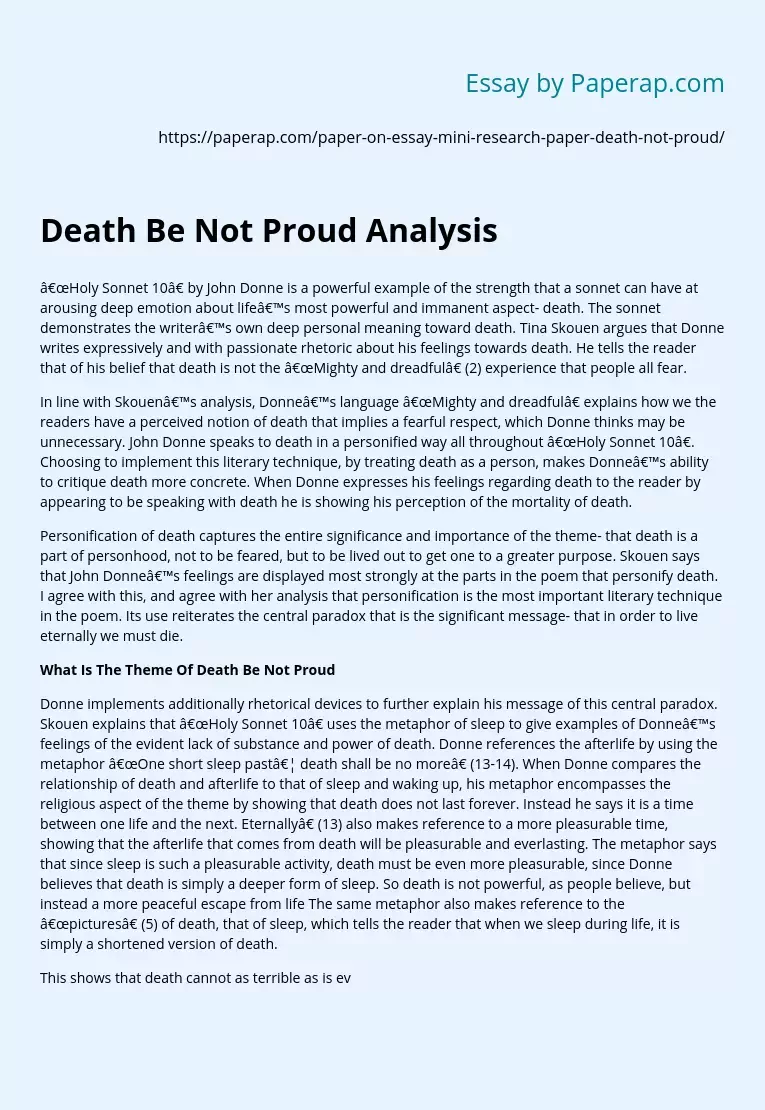Death Be Not Proud Analysis
“Holy Sonnet 10” by John Donne is a powerful example of the strength that a sonnet can have at arousing deep emotion about life’s most powerful and immanent aspect- death. The sonnet demonstrates the writer’s own deep personal meaning toward death. Tina Skouen argues that Donne writes expressively and with passionate rhetoric about his feelings towards death. He tells the reader that of his belief that death is not the “Mighty and dreadful” (2) experience that people all fear.
In line with Skouen’s analysis, Donne’s language “Mighty and dreadful” explains how we the readers have a perceived notion of death that implies a fearful respect, which Donne thinks may be unnecessary.
John Donne speaks to death in a personified way all throughout “Holy Sonnet 10”. Choosing to implement this literary technique, by treating death as a person, makes Donne’s ability to critique death more concrete. When Donne expresses his feelings regarding death to the reader by appearing to be speaking with death he is showing his perception of the mortality of death.
Personification of death captures the entire significance and importance of the theme- that death is a part of personhood, not to be feared, but to be lived out to get one to a greater purpose. Skouen says that John Donne’s feelings are displayed most strongly at the parts in the poem that personify death. I agree with this, and agree with her analysis that personification is the most important literary technique in the poem. Its use reiterates the central paradox that is the significant message- that in order to live eternally we must die.
What Is The Theme Of Death Be Not Proud
Donne implements additionally rhetorical devices to further explain his message of this central paradox. Skouen explains that “Holy Sonnet 10” uses the metaphor of sleep to give examples of Donne’s feelings of the evident lack of substance and power of death. Donne references the afterlife by using the metaphor “One short sleep past… death shall be no more” (13-14). When Donne compares the relationship of death and afterlife to that of sleep and waking up, his metaphor encompasses the religious aspect of the theme by showing that death does not last forever. Instead he says it is a time between one life and the next. Eternally” (13) also makes reference to a more pleasurable time, showing that the afterlife that comes from death will be pleasurable and everlasting. The metaphor says that since sleep is such a pleasurable activity, death must be even more pleasurable, since Donne believes that death is simply a deeper form of sleep. So death is not powerful, as people believe, but instead a more peaceful escape from life The same metaphor also makes reference to the “pictures” (5) of death, that of sleep, which tells the reader that when we sleep during life, it is simply a shortened version of death.
This shows that death cannot as terrible as is everyone believed. The metaphor very effectively expresses the theme. It removes death from its mystery, and makes death seem simple and understandable. Skouen points out how Donne’s critiques the view of immortality and pride in death. He says, “Thou art slave to fate, chance, kings, and desperate men” (9). This comparison makes death seem to be dependant on outside forces other than its own, in particular, the forces of men. In his view of death as dependant on man, Donne shows us that rather than death being overpowering, man is in fact more in control of death than death is.
An additional comparison Donne uses in explaining how death is short and not the eternal state of life is “soonest our best men with thee do go, / Rest their bones, and soul’s delivery” (7-8). The metaphor implies that death is sort-lived, a “rest” instead of an everlasting state.
Works Cited Skouen, Tina. “The Rhetoric of Passion in Donne’s Holy Sonnets. ” Rhetorica: A Journal of the History of Rhetoric 27. 2 (2009): 159-165. Web. 27 Nov 2010. <http://www. jstor. org/stable/40232638>.
Death Be Not Proud Analysis. (2019, Dec 05). Retrieved from https://paperap.com/paper-on-essay-mini-research-paper-death-not-proud/

